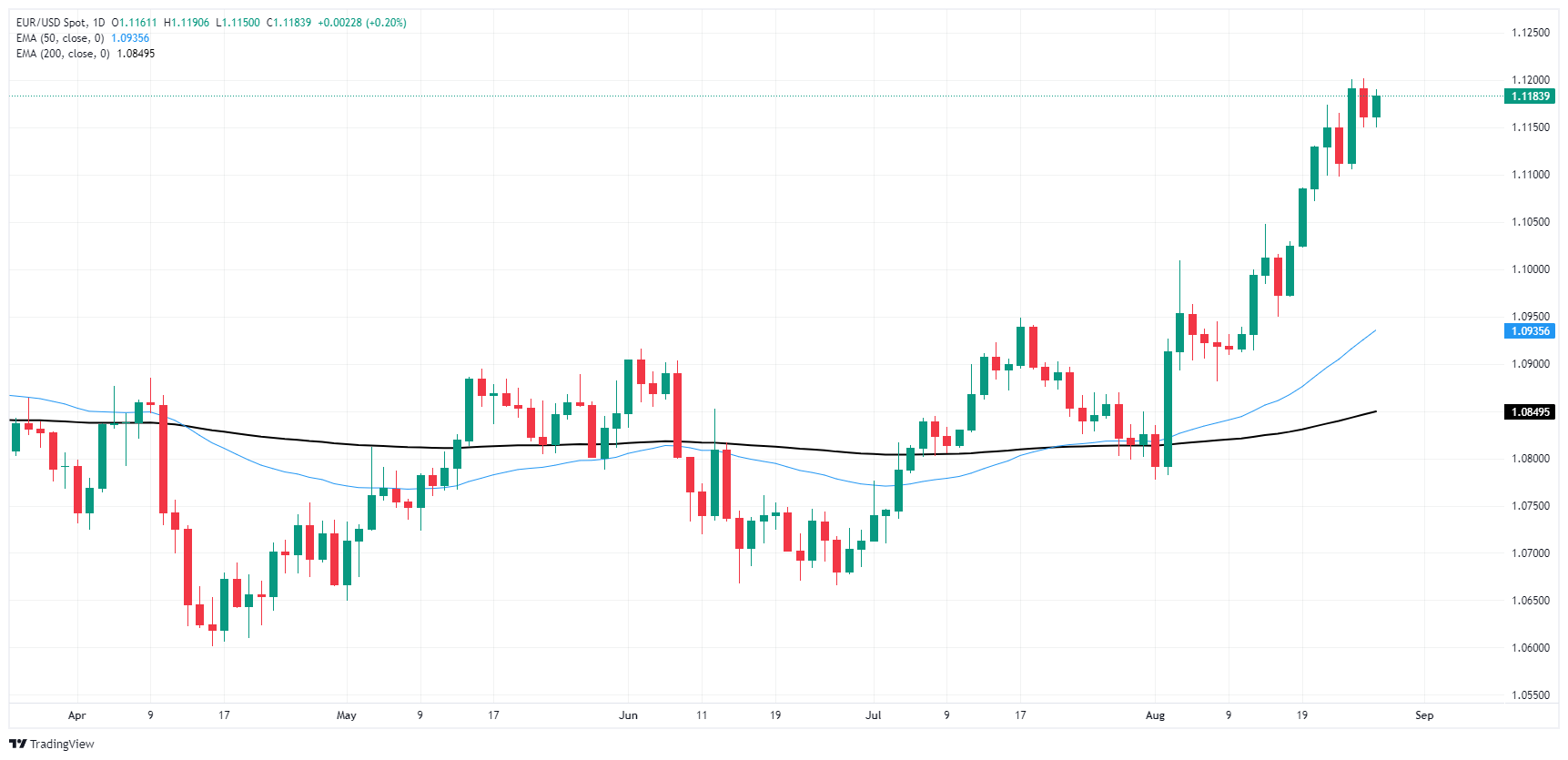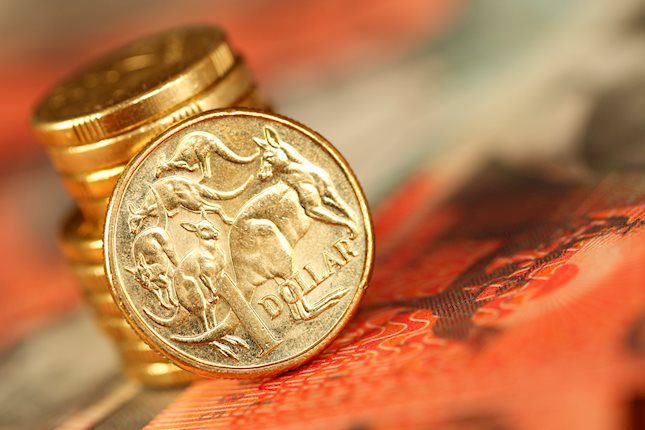- EUR/USD rose on Tuesday, but bulls remain unable to pierce 1.1200.
- Wednesday’s market session promises little momentum with a thin calendar.
- EU and US inflation data looms large on Friday, but little meaningful until then.
EUR/USD drifted into the high side on Tuesday, bolstered by a continued broad-market easing in Greenback bidding pressure. Fiber ticked back into the high end after the trading week kicked off with a slight pare back in recent gains, but a fresh round of risk-on market sentiment sent bids back into recent highs. Still, the pair remains trapped below the 1.1200 handle as Euro bulls struggle to confidently force Fiber higher.
Fed Chair Jerome Powell all but confirmed that the central bank will pivot into a rate-cutting cycle on September 18 during an appearance at the Jackson Hole Economic Symposium last Friday, sending market appetite into the ceiling once again.
Coming up on Wednesday: Markets set for a quiet day
Little of note is populating the economic calendar on the Euro side, and Wednesday is shaping up to be a quiet session on both sides of the Atlantic. Fedspeak traders will have an eye out for a speech from Fed Board of Governors member Christopher Waller early in the US market session, while central bank watchers will be on the lookout for any headlines from the EU’s Eurogroup meeting slated for the European market session.
What happened on Tuesday
Mixed prints in US housing price data from June gave investors little to go on. The Federal Housing Finance Agency’s MoM Housing Price Index contracted -0.1% compared to May’s print of 0.0%. Markets expected a print of 0.2%. The S&P/Case-Shiller Home Price Indices, meanwhile, rose 6.5% YoY, less than the previous period’s revised 6.9%, but still more than the expected 6.0%.
Coming up: EU, US inflation data drops
Pan-EU Harmonized Index of Consumer Prices inflation numbers for August are due early Friday, and price growth across the Euro area are expected to tick down to 2.8% YoY compared to the previous 2.9% as inflationary pressures continue to ease, though not nearly as fast as policymakers at the European Central Bank (ECB) would like.
US Q2 Gross Domestic Product (GDP) figures are slated to print on Thursday, and are expected to hold steady at 2.8% on an annualized basis. However, the key data print this week will be Friday’s US Personal Consumption Expenditure (PCE) Price Index inflation reading for July, which is expected to tick higher YoY to 2.7% from 2.6% and hold flat at 0.2% MoM. Market participants absolutely giddy over hopes for rate cuts will be looking for inflation data to come in below expectations, while an above-forecast print could send fresh jitters through investor risk appetite.
Forex Today: Lack of enthusiasm points to some consolidation
EUR/USD price forecast
EUR/USD is on pace for its best single-month performance since November of 2022, up over 3.1% just in the month of August. Despite this week’s early technical exhaustion pullback, Fiber has gained ground for four consecutive trading weeks, and is bidding well above the 200-day Exponential Moving Average (EMA) at 1.0832.
Despite a healthy bid deep into bull country, Fiber is running a deep exposure to a bearish pullback, and a lack of topside momentum could see price action tumble all the way back to the 50-day EMA at 1.0925.
EUR/USD daily chart
Euro FAQs
The Euro is the currency for the 20 European Union countries that belong to the Eurozone. It is the second most heavily traded currency in the world behind the US Dollar. In 2022, it accounted for 31% of all foreign exchange transactions, with an average daily turnover of over $2.2 trillion a day. EUR/USD is the most heavily traded currency pair in the world, accounting for an estimated 30% off all transactions, followed by EUR/JPY (4%), EUR/GBP (3%) and EUR/AUD (2%).
The European Central Bank (ECB) in Frankfurt, Germany, is the reserve bank for the Eurozone. The ECB sets interest rates and manages monetary policy. The ECB’s primary mandate is to maintain price stability, which means either controlling inflation or stimulating growth. Its primary tool is the raising or lowering of interest rates. Relatively high interest rates – or the expectation of higher rates – will usually benefit the Euro and vice versa. The ECB Governing Council makes monetary policy decisions at meetings held eight times a year. Decisions are made by heads of the Eurozone national banks and six permanent members, including the President of the ECB, Christine Lagarde.
Eurozone inflation data, measured by the Harmonized Index of Consumer Prices (HICP), is an important econometric for the Euro. If inflation rises more than expected, especially if above the ECB’s 2% target, it obliges the ECB to raise interest rates to bring it back under control. Relatively high interest rates compared to its counterparts will usually benefit the Euro, as it makes the region more attractive as a place for global investors to park their money.
Data releases gauge the health of the economy and can impact on the Euro. Indicators such as GDP, Manufacturing and Services PMIs, employment, and consumer sentiment surveys can all influence the direction of the single currency. A strong economy is good for the Euro. Not only does it attract more foreign investment but it may encourage the ECB to put up interest rates, which will directly strengthen the Euro. Otherwise, if economic data is weak, the Euro is likely to fall. Economic data for the four largest economies in the euro area (Germany, France, Italy and Spain) are especially significant, as they account for 75% of the Eurozone’s economy.
Another significant data release for the Euro is the Trade Balance. This indicator measures the difference between what a country earns from its exports and what it spends on imports over a given period. If a country produces highly sought after exports then its currency will gain in value purely from the extra demand created from foreign buyers seeking to purchase these goods. Therefore, a positive net Trade Balance strengthens a currency and vice versa for a negative balance.
Information on these pages contains forward-looking statements that involve risks and uncertainties. Markets and instruments profiled on this page are for informational purposes only and should not in any way come across as a recommendation to buy or sell in these assets. You should do your own thorough research before making any investment decisions. FXStreet does not in any way guarantee that this information is free from mistakes, errors, or material misstatements. It also does not guarantee that this information is of a timely nature. Investing in Open Markets involves a great deal of risk, including the loss of all or a portion of your investment, as well as emotional distress. All risks, losses and costs associated with investing, including total loss of principal, are your responsibility. The views and opinions expressed in this article are those of the authors and do not necessarily reflect the official policy or position of FXStreet nor its advertisers. The author will not be held responsible for information that is found at the end of links posted on this page.
If not otherwise explicitly mentioned in the body of the article, at the time of writing, the author has no position in any stock mentioned in this article and no business relationship with any company mentioned. The author has not received compensation for writing this article, other than from FXStreet.
FXStreet and the author do not provide personalized recommendations. The author makes no representations as to the accuracy, completeness, or suitability of this information. FXStreet and the author will not be liable for any errors, omissions or any losses, injuries or damages arising from this information and its display or use. Errors and omissions excepted.
The author and FXStreet are not registered investment advisors and nothing in this article is intended to be investment advice.
Recommended content
Editors’ Picks

AUD/USD corrects toward 0.6850, awaits US PCE Price Index
AUD/USD is falling back toward 0.6850 in Friday's Asian trading, reversing from near 19-month peak. A tepid US Dollar bounce drags the pair lower but the downside appears called by the latest Chinese stimulus measures, which boost risk sentiment ahead of US PCE data.

USD/JPY pares gains below 145.50 after Tokyo CPI inflation data
USD/JPY is paring back gains to trade below 145.50 in the Asian session on Friday, as Tokyo CPI inflation data keep hopes of BoJ rate hikes alive. However, intensifying risk flows on China's policy optimism support the pair's renewed upside. The focus shifts to the US PCE inflation data.

Gold price consolidates below record high as traders await US PCE Price Index
Gold price climbed to a fresh all-time peak on Thursday amid dovish Fed expectations. The USD languished near the YTD low and shrugged off Thursday’s upbeat US data. The upbeat market mood caps the XAU/USD ahead of the key US PCE Price Index.

Avalanche rallies following launch of incentive program for developers
Avalanche announced the launch of Retro9000 on Thursday as part of its larger Avalanche9000 upgrade. Retro9000 is a program designed to support developers with up to $40 million in grants for building on the Avalanche testnet.

RBA widely expected to keep key interest rate unchanged amid persisting price pressures
The Reserve Bank of Australia is likely to continue bucking the trend adopted by major central banks of the dovish policy pivot, opting to maintain the policy for the seventh consecutive meeting on Tuesday.

Five best Forex brokers in 2024
VERIFIED Choosing the best Forex broker in 2024 requires careful consideration of certain essential factors. With the wide array of options available, it is crucial to find a broker that aligns with your trading style, experience level, and financial goals.